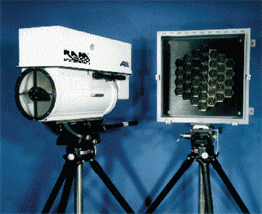| Technology |
Chemicals Detected |
Detection Limits |
Interferents |
Effective Path Length |
Advantages |
Limitations |
General Uses |
| DIAL LIDAR |
Numerous organic and inorganic compounds |
Low ppbv |
Depends upon target chemical |
Up to 10s of km |
- Gated reception allows for contaminant concentration contouring
- Operates only in point and shoot mode without retroreflectors
|
- Measures one chemical or class of chemicals at a time
|
- Contouring atmospheric gases and aerosols from earth, aircraft, or space-based platforms
- Contouring fugitive gas emissions at chemical plants and refineries
- Locating natural gas pipeline leaks from aircraft
- Industrial stack monitoring
|
| OP-FTIR |
Numerous organic and inorganic compounds, and acids (EPA/NIST spectral database contains 350 entries) |
Low ppbv |
CO2, H2O (high humidity) |
1,000 m in bistatic mode; 500 m in mono-static mode |
- Quantitative measure-ment of multiple chemicals at one time
- Large linear range
|
- For best detection limits requires cryogenic cooling
- Only molecular species can be detected
- Homonuclear diatomic species cannot be detected (e.g., Cl2, N2)
|
- Passive mode stack emissions and flares
- Gas emissions from capped landfills
- Facility fence-line monitoring
- Cleanup perimeter monitoring
- Air quality monitoring
- Monitoring volcanic eruption gases
- Aircraft monitoring of airborne plumes
[Click for more info]
|
| Raman |
Numerous organic and inorganic compounds |
ppmv to several percent for open path;
ppb for SERS |
Depends upon target chemical; unlike FTIR, not sensitive to CO2 or H2O |
Depending upon target concentration, portable instruments usually under 100 m and often under 50 m; 10 km or more for fixed LIDAR atmospheric equipment |
- Quantitative measurement of multiple chemicals at one time
|
- High detection limits in open path mode
|
- Fugitive emissions from chemical and refinery processes
- Point and shoot, normally at very close range, to identify hazardous materials, plastic composition, mineral composition, and drugs
- Identification of chemical warfare aerosols
- Used in conjunction with large fixed LIDAR unit to identify air pollutants and water vapor
- Chemical process monitoring
[Click for more info]
|
| TDLs |
Low molecular-weight gases |
Sub ppbv to ppmv (ppm for hand-held passive configuration)
|
Tunability eliminates or minimizes interferents |
1 km |
- Light weight and easily deployed
|
- Measures one chemical compound per tuning
- May require cryogenic cooling for best detection limits
|
- Combustion gas monitoring of boiler incinerator efficiency
- Industrial stack monitoring
- Process tank and line monitor-ing for fugitive emissions
- Natural gas line monitoring
- Facility fence-line monitoring
[Click for more info]
|
| UV-DOAS |
SOx, NOx, NH3, HF, O3, mono-aromatics (BTEX), and aldehydes (HCHO) |
Low ppbv to sub ppbv |
O2 with BTEX |
10 or more km |
- Continuous monitoring
- Relatively low detection limits
|
- Detects limited number of chemical species
|
- Urban air pollution monitoring
- Facility fence-line monitoring
- Airport plane exhaust monitoring
- Traffic exhaust monitoring
- In-plant storage/process area ambient monitoring
- Stratospheric pollutants
- Tropospheric pollutants
[Click for more info]
|




